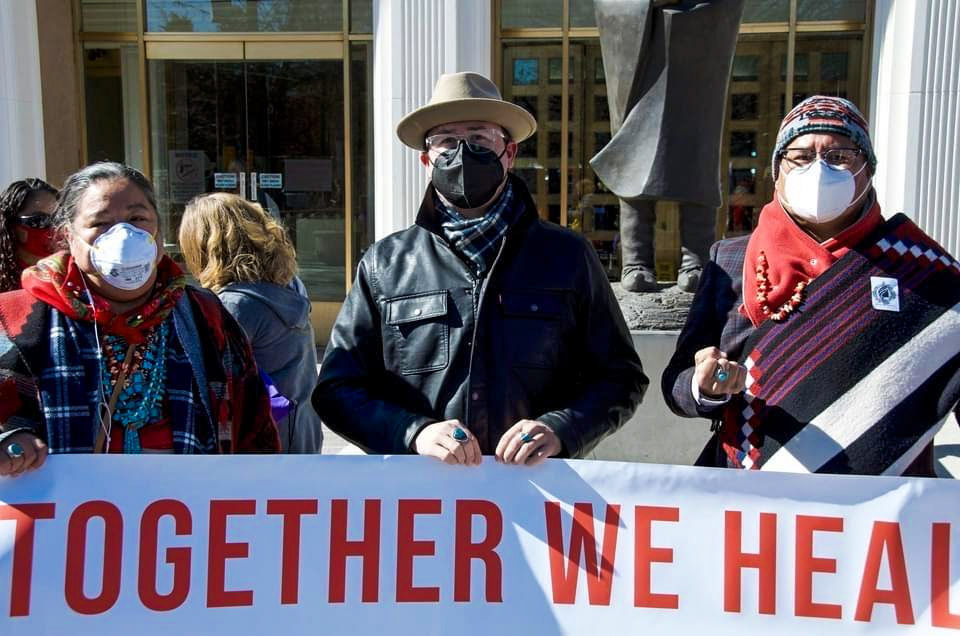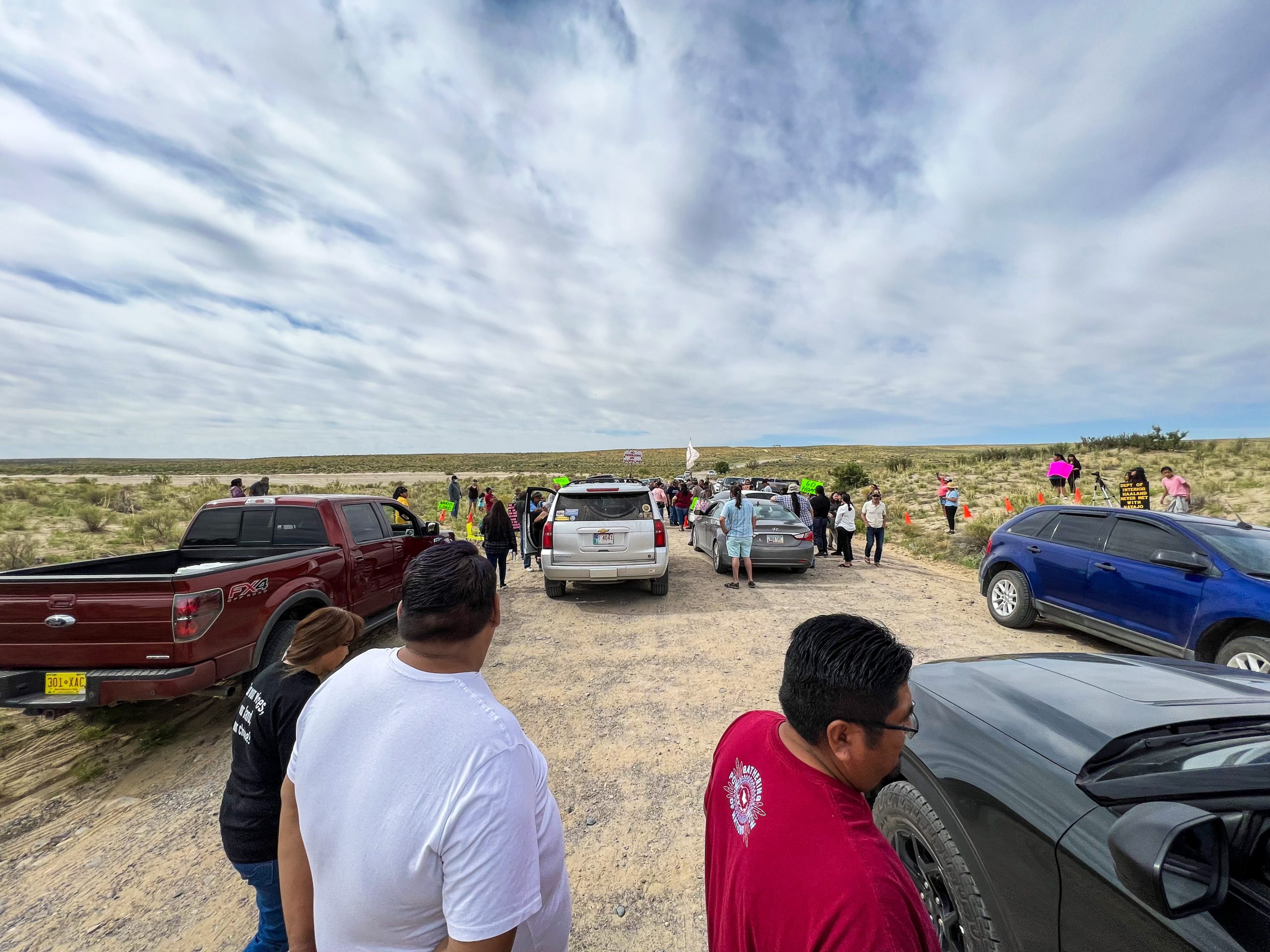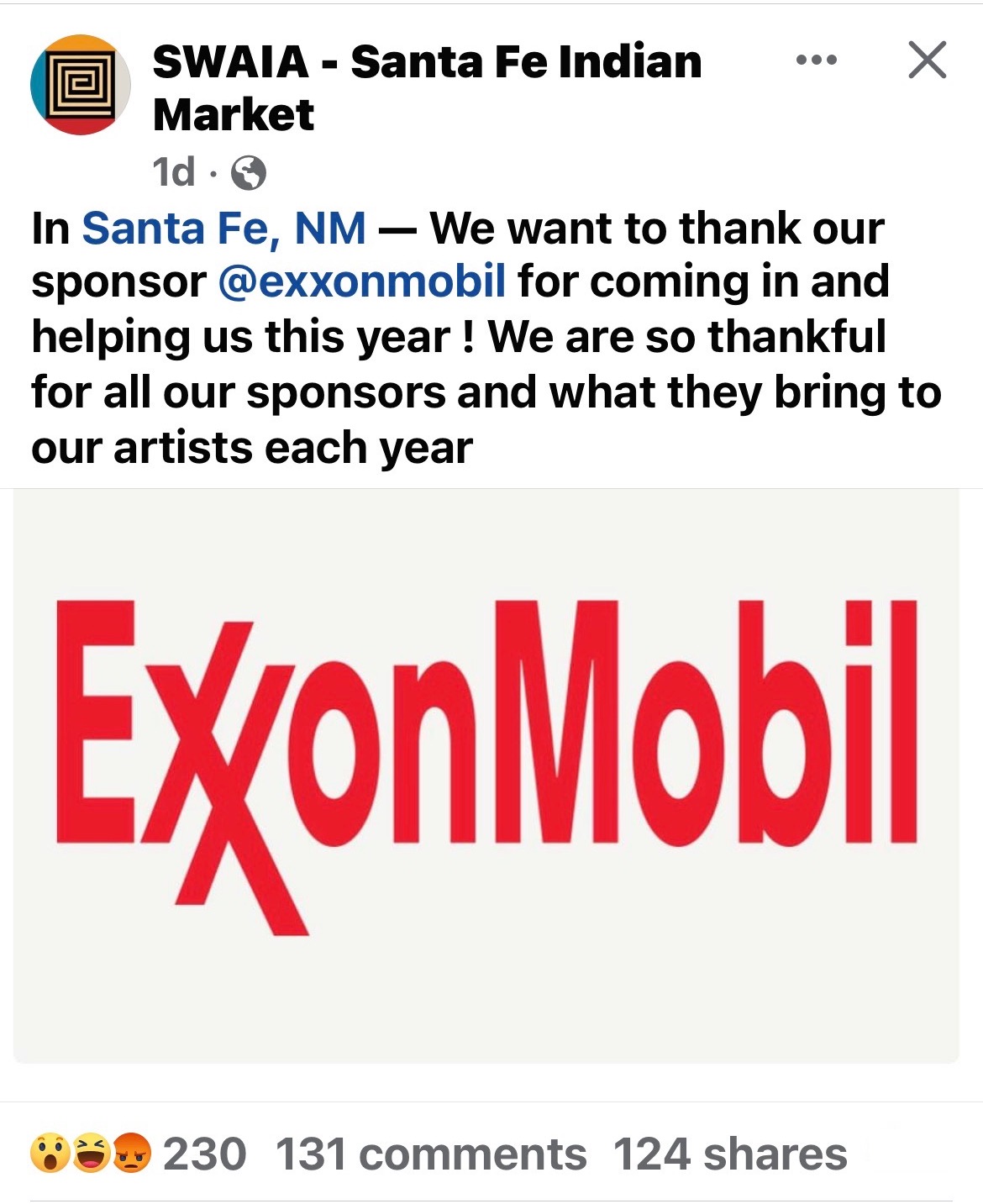Indianz.Com >
News > Indian Market sponsorship draws criticism for ties to energy industry
 Dancers perform at the Santa Fe Indian Market, an event that attracts tens of thousands of visitors to Santa Fe, New Mexico, during the third weekend of August. The event celebrated its 100th anniversary in 2022 and its 101st in 2023. Photo by Indianz.Com (CC BY-NC-SA 4.0)
Dancers perform at the Santa Fe Indian Market, an event that attracts tens of thousands of visitors to Santa Fe, New Mexico, during the third weekend of August. The event celebrated its 100th anniversary in 2022 and its 101st in 2023. Photo by Indianz.Com (CC BY-NC-SA 4.0)
Indian Market criticized for accepting energy industry sponsorship
Oil and gas development stirs strong feelings in New Mexico
Wednesday, September 6, 2023
By Acee Agoyo
Indianz.Com
The organization that puts on the largest juried Indian art market in the world continues to face criticism on social media after thanking a sponsor of the popular event.
The
Southwestern Association for Indian Arts hosted the
101st Santa Fe Indian Market from August 16-20. The event attracted upwards of 100,000 visitors to New Mexico’s capital city for a busy weekend of art, fashion, food, film, song, dance and more — all created by American Indian and Alaska Native artists from the United States and First Nations artists from Canada.
But it was a post-market show of gratitude that sparked fury online. The non-profit SWAIA thanked ExxonMobil, one of the
world’s largest publicly traded oil and gas companies, for being one of the sponsors of a multi-day event that features more than 1,000 artists and relies on dozens of volunteers to be a success.
“We are so thankful for all our sponsors and what they bring to our artists each year,” the post, which went up about a week after the festivities concluded, stated.
A screenshot of a social media post — since deleted — stirred controversy when the non-profit organization that puts on the Santa Fe Indian Market thanked a sponsor of the popular event.
ExxonMobil had
had touted its sponsorship of Indian Market on social media during the event. And the company’s logo appeared on SWAIA’s website as one of several sponsors well before the activities got underway in Santa Fe.
The more recent post, however, attracted negative attention — much of it from Native people. They questioned why SWAIA accepted money from a major player in an industry that has contributed to the exploitation of tribal lands and to the crisis of missing and murdered relatives.
“Last executive director said they were going corporate,” a prominent Native artist in New Mexico, one who has participated in Indian Market, wrote in a comment on the post. “Guess this is how they do.”
But the artist’s comment, as well as hundreds of other reactions to ExxonMobil’s involvement, are no longer available on any of SWAIA’s social media channels. The organization deleted the offending post, erasing the criticism that has since spread to other platforms as Native people and others continue to express opposition to the corporate donation.
“They (SWAIA) did a thank you post the other day and had to remove it as it didn’t go the way they thought it would,” one person wrote onf
ExxonMobil’s post about the sponsorship, where critical comments have migrated.
“I can’t believe they are accepting the money from them,” another person said in response. “I doubt they will reverse that decision.”
According to a public relation executive who helps handle media inquiries for SWAIA, ExxonMobil contributed $30,000 to the organization for this year’s Indian Market, which was the 101st such event.
“They have an initiative to invest in communities and especially BIPOC communities and were interested in coming alongside market to sponsor volunteers, volunteer t-shirts and some operational expenses,” Audrey Nadia Rubinstein said of ExxonMobil’s participation in Indian Market.
Rubinstein confirmed that SWAIA removed the thank you post, which had appeared on Facebook and Instagram. She described the original message as being “unapproved.”
“It was deleted because it was an unapproved post that did not thoughtfully lay out their involvement and provided no context,” Rubinstein told Indianz.Com via email on Wednesday.
Rubinstein also said she believed ExxonMobil hadn’t previously been a sponsor of Indian Market. SWAIA’s website shows the company’s logo along with logos of other supporters of the 2023 event, including 19 tribal nations, Native entities and. Native businesses,
When asked whether SWAIA planned to post again about ExxonMobil’s sponsorship — this time with more context — Rubinstein said to expect another one in the coming days.
After being contacted by Indianz.Com, a media analyst for ExxonMobil asked for more information about the donation the company made to SWAIA. A response hasn’t been received as of Wednesday afternoon.
 In February 2022, Navajo Nation Council delegates took part in a march to bring awareness to missing and murdered relatives in New Mexico. Seen at the New Mexico Roundhouse in the state capital of Santa Fe, from left, are Kanazbah Crotty, Carl Slater and Nathaniel Brown. Crotty and Slater continue to serve on the council. Photo courtesy Navajo Nation Council
In February 2022, Navajo Nation Council delegates took part in a march to bring awareness to missing and murdered relatives in New Mexico. Seen at the New Mexico Roundhouse in the state capital of Santa Fe, from left, are Kanazbah Crotty, Carl Slater and Nathaniel Brown. Crotty and Slater continue to serve on the council. Photo courtesy Navajo Nation Council
New Mexico is home to 19 distinct
Pueblo tribes, the
Jicarilla Apache Nation, the
Mescalero Apache Tribe and the
Navajo Nation. American Indians and Alaska Natives represent about 12.4 percent of the population in the state,
according to the U.S. Census Bureau, coming in third after Alaska and Oklahoma in terms of proportion of Native people.
New Mexico has officially declared the crisis of missing and murdered Native people — especially women and girls — as an “epidemic.” A task force led by Native women in the state singled out the energy industry for contributing to the high rates of violence.
“With New Mexico being dependent on oil and gas for state revenue, it is no surprise that New Mexico currently has the highest rate of MMIWR cases in the nation and Albuquerque is the city with the second highest,” the Missing and Murdered Indigenous Women and Relatives (MMIWR) task force said in its
initial report from December 2020.
Energy extraction is in fact on the rise in the state, despite the warnings from Native women. The
New Mexico Oil and Gas Association said the industry generated over $63.3 billion in fiscal year 2022 — an increase of 132 percent from the year prior. [PDF:
Fueling New Mexico]
Much of the
oil and gas activity in New Mexico occurs in the southeastern part of the state, in an area that borders Texas, where energy extraction also plays a significant role in the economy. Along with Oklahoma, which boasts the second-highest percentage of Native people, and Kansas, the four states are home to
large deposits of oil and gas resources on federal lands.
“BLM New Mexico (including Oklahoma, Texas, and Kansas) has one of the largest oil and gas programs in the Bureau,”
according to the Bureau of Land Management, a federal agency that is part of the
Department of the Interior.
“The four-state area has over 45 million acres of mineral estate and more than 2 million acres of Native American mineral estate,” the agency notes.
BLM New Mexico further points out that the northwestern part of the state is home to another prominent oil and gas area in the
San Juan Basin. The Navajo Nation has historically participated in such development, with the tribal government as well as individual Navajo citizens opening their lands to resource extraction.
 Landowners from the Navajo Nation block a road to Chaco Culture National Historic Park in New Mexico in protest of a visit by Secretary of the Interior Deb Haaland on June 11, 2023. Courtesy photo
Landowners from the Navajo Nation block a road to Chaco Culture National Historic Park in New Mexico in protest of a visit by Secretary of the Interior Deb Haaland on June 11, 2023. Courtesy photo
Navajo reliance on oil and gas development in New Mexico sparked significant criticism of
Secretary of the Interior Deb Halaand, who is the first Native person to serve in a presidential cabinet. In June, she was forced to abandon a celebration she had planned at
Chaco Culture National Historical Park, where new extraction has been prohibited within a 10-mile radius of an area sacred to Pueblo and Navajo peoples.
“Efforts to protect the Chaco landscape have been ongoing for decades, as tribal communities have raised concerns about the impacts that new development would have on areas of deep cultural connection,”
Haaland said in announcing the ban on June 2.
Although the prohibition only applies to federal lands around Chaco, leaders of the Navajo Nation said it would hinder development on tribal lands.
President Buu Nygren, who took office earlier this year, was among those who spoke out against Haaland, which marked a rare instance of criticism of the Native trailblazer.
“The Biden administration has undermined the position of the Navajo Nation with today’s action and impacted the livelihood of thousands of Navajo allotment owners and their families,” Nygren said in a
news release at the time.
On June 11, the day of the celebration, Navajo landowners blocked the path to Chaco, with some carrying signs telling Haaland to “Go Home.” Others declared the area to be “Navajo Nation Land.”
Haaland is a citizen of the Pueblo of Laguna, one of the tribes with ancestral, historic and ongoing connections to Chaco. Her team ended up
staging the event at the
Indian Pueblo Cultural Center in Albuquerque, the largest city in New Mexico. The facility is jointly owned by the 19 Pueblo tribes in the state.
NDN Collective: What is Happening in Chaco Canyon: A community debrief and discussion on peacekeeping
In the days following the dustup, Navajo citizens who support the ban on development at Chaco
took part in an online presentation in which they blamed Nygren for not being properly “briefed” about Haaland’s decision. They noted that the prior president of their tribe, Jonathan Nez,
advocated for permanent protections on the sacred and ancestral area.
But in the days afterward,
NDN Collective said oil and gas companies with interests in the area were spreading “misinformation” about the Chaco ban and how it affects Navajo landowners. According to the Native-led organization, four “private operators” own mining and drilling assets in the San Juan Basin. ExxonMobil, which is
publicly traded in the United States, is not one of them.



